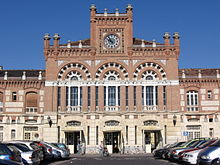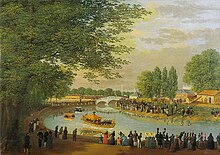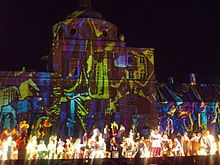Aranjuez Cultural Landscape
Located in the southern end of the region, the main urban nucleus lies on the left bank of the Tagus, a bit upstream of the discharge of the Jarama. As of 2022, the municipality has a registered population of 59,762. Aranjuez became one of the Royal Estates of the Crown of Spain in 1560, during the reign of Philip II. Until 1752, only royalty and nobility were allowed to dwell in the town.
The cultural landscape of Aranjuez was declared a World Heritage Site by UNESCO in 2001.
Name
There are several theories about the origin of the name. The most widely-accepted one states that it comes from Basque and derives it from arantza ("hawthorn" in English). Another theory, attributed to Padre Martín Sarmiento, a Benedictine scholar who lived about a century after the founder of Aranjuez, Philip II of Spain, claims the origin to be from Latin Ara Jovis or Ara Iovia, which means the altar of the Roman god Jupiter. However the pre-Roman derivation is generally preferred.
History
Early history
Alfonso VI took control of the territory near the Tagus, including Aranjuez, after the 1085 conquest of the Taifa of Toledo. During the 12th century, Aranjuez (then known as Aranz, Aranzuel, Aranzuegue or Almuzundica) was a small hamlet under the influence of the castle of Oreja. Following the 1108 defeat of Castilian and Leonese forces by the Almoravids at Uclés, the area fell under Muslim control. Aurelia (Oreja) was retaken by Alfonso VII, the Emperor after the 1194 surrender of the besieged castle. Alfonso VIII donated Oreja and its dependent hamlets in 1171 to the Order of Santiago and its Grand Master Pedro Fernández. Aranjuez was definitively secured in 1178.
Aranjuez was chosen as seat of the Mesa Maestral ("Master's Table") of the Order of Santiago in 1272. The link between Aranjuez and the Crown dates from 1493, when the Catholic Monarchs became administrators of the military orders. Adrian VI confirmed Emperor Charles V in the everlasting dignity as Grand Master of the Order in 1523. The dehesa of Aranjuez subsequently became a Crown property.
Development as Royal Site

Philip II declared the place a Royal Site in 1560. In the second half of the 16th century, the royal palace was constructed and the name of the enlarged settlement was changed from Alpajes to Aranjuez. The site was initially designed by Juan Bautista de Toledo and completed by Juan de Herrera. Aranjuez was extensively redesigned in the 18th century by Santiago Bonavía.
In 1752, during the reign of Ferdinand VI, Aranjuez, which was previously reserved for the royal family, nobles of the royal court and palace servants started to be opened providing overnight accommodation for visitors, who had previously been obliged to lodge in nearby settlements such as Ocaña.
The weir in the Tagus River which is alongside to the Royal Palace of Aranjuez was constructed in 1753 to power a water wheel for milling wheat flour. Since the mill was visible from the palace, it was architecturally attractive and sometimes used as the residence of the town governor.
King Carlos III built the so-called Long Bridge (about 300m long) over the Jarama in 1761.
In 1763 Charles III, a keen physiocrat ordered the construction of Real Cortijo de San Isidro, a model farm which was abandoned by his successor (his second son, Charles IV of Spain) and later commercialized. Two years later the king ordered the construction of the Franciscan Convent of San Pascual, later occupied by the Conceptionists.
The French architect Jaime Marquet began construction of the theatre Coliseum Carlos III in 1767.

An uprising, the so-called Mutiny of Aranjuez, took place on 17 March 1808 when the royal family and the government were staying at Aranjuez on their way south, as they were anticipating a French invasion from the north. Soldiers, peasants and members of the general public assaulted Manuel Godoy's quarters and captured him. The mutineers made Charles dismiss Godoy, and two days later, the court forced the King himself to abdicate in favour of his son and rival, who became Ferdinand VII.
Late modern history

Railway transport arrived to Aranjuez on 9 February 1851, with the opening of the Madrid–Aranjuez line, the second in the Iberian Peninsula after Barcelona–Mataró (not the second in Spain, as the Havana–Güines line had been opened in Cuba in 1837). Aranjuez was granted the title of town (villa) in 1899.
In the context of the 1936–1939 Spanish Civil War, Aranjuez remained under Republican control until the end of the conflict, becoming the headquarters of the 9th Division of the Spanish Republican Army. Important battles of the war such as the Battle of Seseña and the Battle of Jarama took place not far from Aranjuez. Following the seizure by the Rebel faction, a Francoist concentration camp was active in Aranjuez in 1939.
Main sites
| Aranjuez Cultural Landscape | |
|---|---|
| Official name | Aranjuez Cultural Landscape |
| Type | Cultural |
| Criteria | ii, iv |
| Designated | 2001 (25th session) |
| Reference no. | 1044 |
| Region | Europe and North America |
The city was declared Conjunto Histórico-Artístico ("Historic Artistic Junction") in 1983. In 2001 UNESCO listed the Aranjuez Cultural landscape as a World Heritage Site.
Mariblanca
This was the first extension beyond the Royal Palace, along the south bank of the river Tagus (Local spelling Tajo). The royal Church of San Antonio which was built by Philip IV of Spain for both public and ceremonial royal use, stands at the southern end of Plaza San Antonio popularly known as Mariblanca, (possibly because it is a 'sea' of white sand or mar de arena blanca or else an allusion to the female statue of the fountain at the far end, which is the Venus of sculptor Juan Reyna in 1762).
Plaza de Toros
This section needs additional citations for verification. (October 2022) |
A bullring, one of the earliest in Spain, the original was built in 1760 by order of King Charles IV, the refurbished structure was opened by his wife, Maria Luisa of Parma, on 14 May 1797. It had a capacity of 9000 spectators at a time when the population, according to the then prime minister, was only 4226. There are twelve public entrances which lead to three circular galleries, each with 10 stone seating benches. Royalty and their guests enjoyed a private entrance with stairs leading directly to the royal box.
Following a fire in 1809, King Ferdinand VII had it rebuilt and donated it to the town, which installed a small museum (usually only open to the public Saturday, Sunday and Monday mornings at 11.15)





